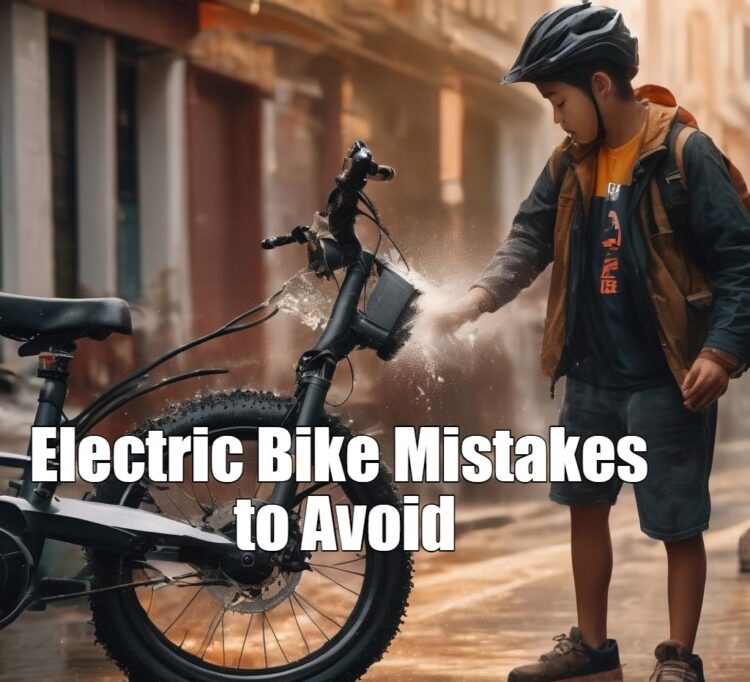Electric Bike Mistakes to Avoid
Electric bikes have surged in popularity over recent years, offering a sustainable transportation solution that blends the benefits of traditional cycling with the convenience of motor-assisted pedaling. However, as more people transition to this mode of transportation, a plethora of mistakes are often made, stemming from misinformation, lack of awareness, or mere oversight. Here, we delve into the common electric bike mistakes to avoid, ensuring a smooth, efficient, and safe e-biking experience.

1. Skimping on Research and Testing
The allure of purchasing an e-bike can often lead potential buyers into making hasty decisions. However, as with any significant investment, thorough research and testing are paramount to ensuring satisfaction and longevity. E-bikes aren’t a one-size-fits-all commodity; they come in a diverse range of models, each meticulously crafted for specific terrains and purposes.
Whether you’re eyeing an e-bike for daily commuting through city lanes, rugged mountain biking adventures, or long-distance touring, understanding the nuanced differences between each model is crucial. Moreover, what might seem perfect in theory might not necessarily translate to comfort and efficiency in practice.
Therefore, always make it a point to test ride several e-bikes. Feel the grip, assess the comfort of the seat, gauge the power delivery, and observe its maneuverability. Such hands-on experiences can offer invaluable insights that mere specifications on paper might not convey, ensuring that when you finally make a purchase, it’s aligned with both your needs and expectations.
2. Overlooking the Battery Quality
When delving into the world of e-bikes, it’s crucial to recognize the significance of the battery. Much like how a heart pumps life into a living being, the battery breathes life into an e-bike, determining its range, power, and efficiency.
However, a misstep that many first-time buyers often make is gravitating towards more affordable options, compromising on battery quality. Such a decision might offer short-term financial savings, but in the long run, a low-quality battery can manifest a multitude of issues. These can range from frustratingly short lifespans and diminished travel ranges to more severe concerns like safety hazards.
Therefore, instead of merely focusing on the price, delve deeper into the specifics of the battery. Investigate the reputation of the brand, understand the capacity in relation to your needs, and most importantly, scrutinize the warranty terms. Often, reputable brands, aware of the robustness and reliability of their batteries, will back them with generous warranties. Investing in such top-tier brands might mean a slightly higher upfront cost, but the reliability, performance, and peace of mind they offer often justify the expenditure.
3. Neglecting Regular Maintenance
E-bikes, while revolutionizing the biking landscape with their blend of manual and electric propulsion, carry with them the responsibilities of upkeep akin to their traditional counterparts. Many e-bike owners, especially those transitioning from regular bicycles, may underestimate the maintenance regimen these modern marvels necessitate. At their core, e-bikes still sport the same fundamental components of a regular bike, meaning they demand the routine checks on brakes, chains, and gear systems.
But the innovation that sets them apart—their electrical components—introduces an added dimension of care. The motor, which powers the assisted pedaling, the connectors that keep the electrical flow intact, and the battery, the e-bike’s veritable powerhouse, all need regular inspections and upkeep. Without this, you risk not just a diminished performance, but also potential malfunctions that could jeopardize the bike’s lifespan and your safety.
In essence, while e-bikes offer enhanced convenience and efficiency, they also call for a holistic maintenance approach, blending the traditional with the modern, to ensure they serve you reliably and efficiently for years to come.
Improper Battery Storage
4. Ignoring Weight Limits
E-bikes, though designed for durability and enhanced performance, come with intrinsic structural constraints. One of these is the weight limit, which is determined by factors like the bike’s frame material, design, and motor capability. Aluminum frames, commonly found in many e-bikes due to their lightweight and corrosion-resistant properties, are particularly sensitive to weight considerations. When riders, either intentionally or inadvertently, load their e-bike beyond its stipulated weight capacity, they’re courting potential problems.
Overloading an e-bike doesn’t just strain the motor, which might need to work harder to deliver the desired speeds and assist levels, but it also puts undue stress on the frame and other structural components. Such persistent stress, especially during regular rides, can lead to wear and tear, compromises in ride quality, and in some cases, irreversible damages. Additionally, an overloaded e-bike can also pose safety risks. The added weight can affect the bike’s balance, braking efficiency, and maneuverability, increasing the likelihood of accidents.
Being conscious of an e-bike’s weight limit and adhering to it isn’t just about ensuring the bike’s longevity; it’s about guaranteeing optimal performance and safety during every ride. Whether it’s the weight of the rider, cargo, or any additional accessories, staying within the recommended limits ensures that the e-bike delivers a consistent, safe, and efficient performance throughout its lifespan.
5. Over-relying on Motor Power
The allure of e-bikes lies significantly in the effortless glide they offer, thanks to their motor assistance. This electric boost, especially on challenging terrains or during moments of fatigue, can transform a grueling ride into a breeze. However, this convenience, if overindulged, comes with its set of drawbacks. Continuously leaning on the motor’s power not only exhausts the battery at a much faster rate, reducing the distance you can cover on a single charge, but it also diminishes one of the fundamental joys and benefits of cycling: physical exercise.
Striking a balance is the key. By toggling between manual pedaling and motor-assisted cycling, riders can ensure they’re still getting a good workout, all while extending the life of their battery. It’s a rhythm that, once mastered, offers the best of both worlds: the cardiovascular benefits of cycling and the comfort of motor assistance when needed. This balanced approach not only sustains the battery’s health and longevity but also enriches the overall e-biking experience, melding fitness and convenience harmoniously.
6. Avoiding Safety Gear
E-bikes, with their motorized assistance, offer a thrilling ride experience often surpassing the speeds achievable with traditional bicycles. This advantage, however, is a double-edged sword. While it allows riders to traverse longer distances quickly, it also amplifies the risks in case of accidents or mishaps. The inherent weight of e-bikes, due to their added components like motors and batteries, further intensifies the impact during collisions or falls.
Hence, the importance of safety gear cannot be stressed enough. A helmet, often considered the primary line of defense, can drastically reduce the severity of head injuries. Given the speeds e-bikes can reach, even a minor accident without a helmet can have serious consequences. Beyond helmets, other protective gear such as gloves offer protection from abrasions, while pads for knees and elbows can cushion falls, preventing fractures or bruises.
But personal protective gear is just one aspect of safety. Considering the times one might ride – during the early hours of dawn, the dusky hours, or even the cover of night – visibility becomes paramount. Adequate lighting, both in the front and rear of the e-bike, ensures that the rider is visible to motorists, other cyclists, and pedestrians. Reflective clothing or accessories can further enhance visibility, ensuring that one is discernible even under low-light conditions.
7. Not Being Prepared for Punctures
E-bikes, for all their technological advancements and conveniences, still share many commonalities with their traditional counterparts, and unfortunately, susceptibility to punctures is one of them. However, due to their added weight from components like batteries and motors, e-bikes face a marginally increased risk of tire punctures. This amplified weight exerts more pressure on the tires, especially when traversing rough or uneven terrains, making them more vulnerable to sharp objects on the path.
Being stranded with a flat tire can be an unwelcome interruption to a pleasant ride. Thus, being proactive is essential. Carrying a puncture repair kit becomes indispensable for any e-bike enthusiast. These kits, typically compact and lightweight, can fit easily into a backpack or saddlebag, ensuring that you have the necessary tools and patches to address a puncture when it occurs.
But having a repair kit is only half the battle; knowing how to use it effectively is equally crucial. E-bikes, with their intricate designs, often have specific configurations around the wheel area, especially with the motor’s placement and associated cabling in motorized hubs. Familiarizing oneself with the nuances of fixing a flat specific to one’s e-bike model can save a lot of time and frustration. Watching tutorials, consulting the user manual, or even practicing at home can make the real-life repair process smoother.
8. Overlooking Local Regulations
The burgeoning popularity of e-bikes has prompted cities and countries worldwide to formulate regulations that govern their use. These rules aim to ensure the safety of riders, pedestrians, and other road users. However, due to the varied nature of e-bikes and their capabilities, there isn’t a universal set of laws that applies uniformly across regions. This mosaic of regulations poses a challenge for e-bike users, especially those who might be using their bikes across different jurisdictions.
For instance, in some places, the legal definition of an e-bike is closely tied to its top speed and motor power. An e-bike capable of speeds beyond a certain threshold might be classified differently, requiring specific licenses, insurance, or even helmets. Similarly, while some cities allow e-bikes on bike paths or dedicated lanes, others might restrict them to roads or prohibit them from pedestrian areas.
Overlooking these regulations can lead not just to hefty fines but also to potential safety hazards. Riding an e-bike at high speeds on paths shared with pedestrians or traditional cyclists can lead to accidents, given the weight and speed differential.
Final Thoughts
Embracing the world of e-biking can be exhilarating, offering a blend of exercise, convenience, and sustainability. However, ensuring you’re well-informed and cautious can make a significant difference in your overall experience. By being aware of and avoiding these common mistakes, you can enhance your e-bike’s longevity, performance, and safety. Happy riding!
